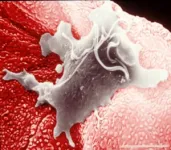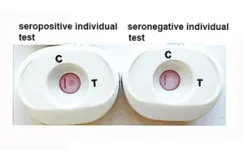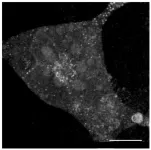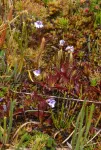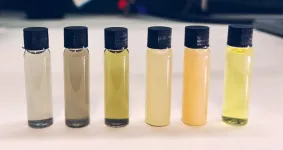(Press-News.org) INDIANAPOLIS, March 27, 2023 — Nobody likes needles, but they’re necessary for delivering many vaccines and biologics into the body. But what if those could be puffed through the skin instead, with just a little pressure, like being hit in the arm with a foam toy? Today, scientists report steps toward making that a reality. Using powdered vaccines that don’t require refrigeration and a system driven by compressed gas, their “MOF-Jet” could easily deliver therapeutics against cancer and other diseases in a relatively painless way.
The researchers will present their results at the spring meeting of the American Chemical Society (ACS). ACS Spring 2023 is a hybrid meeting being held virtually and in-person March 26–30, and features more than 10,000 presentations on a wide range of science topics.
A video on the research is available at www.acs.org/mofjet.
The idea for the project was formed out of pandemic-induced boredom. The project’s principal investigator, Jeremiah Gassensmith, Ph.D., had ordered inexpensive pieces of a compressed gas-powered jet injection system to mess around with while stuck at home. Later, after everyone was back on campus, he handed the pieces over to Yalini Wijesundara, a graduate student in the lab, with the instructions, “See what you can do with this.”
Wijesundara, who is presenting the work at the meeting, took these instructions in stride. She had previously researched other jet injectors dating back to the 1960s that use compressed gas to inject a narrow stream of fluid. If the injectors could be modified to fire solids, she figured, they could deliver cargo encased in metal-organic frameworks, or MOFs, as well. These frameworks are porous, crystalline structures that act like molecular “cages” to encapsulate a wide variety of materials, including nucleic acids and proteins. By combining the jet injector with the lab’s existing work on MOFs, Wijesundara created a “MOF-Jet.” The jet can deliver powders to cells by, quite literally, shooting them in with air. Both Gassensmith and Wijesundara are at The University of Texas at Dallas.
Jet injectors previously saw widespread use in the military, but they were painful and the fluid often splashed back, potentially spreading other diseases such as Hepatitis B. A modern-day descendant is the “gene gun,” which is typically used in veterinary medicine and can cost tens of thousands of dollars. These devices also shoot biological cargo into cells. In this case, the cargo is attached to the surface of a metal microparticle, typically made of gold or tungsten. But once it penetrates the skin, the metal particles remain there and can speed up the degradation of the biological material.
A different strategy would be to put the cargo inside a MOF. Gassensmith’s group previously worked with the MOF called zeolitic-imidazolate framework eight, or ZIF-8. “Compared to gold, it’s cheap and protects biological materials, such as nucleic acids,” explains Wijesundara. “We can also store vaccine formulations within it as powders at room temperature, which eliminates the need for the extremely cold temperatures many liquid vaccines require.”
The team encased a variety of biological materials within ZIF-8, which protected them from being broken down too quickly. To deliver the materials into cells, the team used their own modified, gene gun-inspired “MOF-Jet.” Wijesundara created “bullets” for the device, each loaded with a dose of functionalized ZIF-8, and a puff of gas fired the powdered formulation into cells, which was as easy as just “pointing and shooting.” They tested their system and showed that the MOF-Jet delivered a ZIF-8-encased gene to onion cells and a ZIF-8-encased protein to mice. According to Gassensmith, the blast from the injector just feels “like you got hit with a Nerf bullet” — much less painful than being stuck with a needle.
By tinkering with the MOF-Jet, Wijesundara soon realized that cargo release could be tuned by simply changing the injector’s carrier gas. ZIF-8 is sensitive to acidic environments, and when carbon dioxide reacts with water in cells, it makes carbonic acid that, in turn, helps break apart the MOF. “If you shoot it with carbon dioxide, it will release its cargo faster within cells; if you use regular air, it will take four or five days,” she explains. This means that the same drug could be released over different timescales without changing its formulation. “Once we realized that, it opened up a lot of possibilities,” says Gassensmith.
The team is now using this method to deliver chemotherapeutics and adjuvants as a potential treatment for melanoma, the most serious form of skin cancer. They say that because the MOF-Jet can disperse material over a wide area, it could distribute a cancer therapeutic into a melanoma more evenly than with a needle, which is the current delivery method. And simply by controlling the carrier gas, they could deliver chemotherapeutics with a fast- or slow-release timeframe, depending on a patient’s needs. Though research is still ongoing, preliminary experiments are yielding promising results. Wijesundara and Gassensmith say that the adaptability of their MOF-Jet could allow a wide number of applications, from veterinary medicine to agriculture, or someday even human vaccinations or treatments.
The researchers acknowledge support and funding from the Army Research Laboratory, the National Science Foundation and the Welch Foundation.
A recorded media briefing on this topic will be posted Monday, March 27, by 10 a.m. Eastern time at www.acs.org/acsspring2023briefings. Reporters can request access to media briefings during the embargo period by contacting newsroom@acs.org.
For health and safety information for ACS Spring 2023, please visit the FAQ webpage.
The American Chemical Society (ACS) is a nonprofit organization chartered by the U.S. Congress. ACS’ mission is to advance the broader chemistry enterprise and its practitioners for the benefit of Earth and all its people. The Society is a global leader in promoting excellence in science education and providing access to chemistry-related information and research through its multiple research solutions, peer-reviewed journals, scientific conferences, eBooks and weekly news periodical Chemical & Engineering News. ACS journals are among the most cited, most trusted and most read within the scientific literature; however, ACS itself does not conduct chemical research. As a leader in scientific information solutions, its CAS division partners with global innovators to accelerate breakthroughs by curating, connecting and analyzing the world’s scientific knowledge. ACS’ main offices are in Washington, D.C., and Columbus, Ohio.
To automatically receive news releases from the American Chemical Society, contact newsroom@acs.org.
Note to journalists: Please report that this research was presented at a meeting of the American Chemical Society.
Follow us: Twitter | Facebook | LinkedIn | Instagram
Title
Carrier gas triggered controlled biolistic delivery of DNA and protein therapeutics from metal-organic frameworks
Abstract
The efficacy and specificity of protein, DNA, and RNA-based drugs make them popular in the clinic; however, these drugs are often delivered via injection, requiring skilled medical personnel, and producing biohazardous waste. Here, we report an approach that allows for their controlled delivery, affording either a burst or slow release without altering the formulation. We show that when encapsulated within zeolitic-imidazolate framework eight (ZIF-8), the biomolecules are stable in powder formulations and can be shot with a low-cost gas-powered “MOF-Jet” into living animal and plant tissues. Additionally, their release profiles can be modulated through judicious selection of the carrier gas used in the MOF-Jet. Our in vitro and in vivo studies reveal that, when CO2 is used, it creates a transient and weakly acidic local environment that causes a near-instantaneous release of the biomolecules through an immediate dissolution of ZIF-8. Conversely, when air is used, ZIF-8 biodegrades slowly, releasing the biomolecules over a week. This is the first example of controlled-biolistic delivery of biomolecules using ZIF-8, which provides a powerful tool for fundamental and applied science research.
END
A puff of air could deliver your next vaccine (video)
2023-03-27
ELSE PRESS RELEASES FROM THIS DATE:
Human cells help researchers understand squid camouflage
2023-03-27
INDIANAPOLIS, March 27, 2023 — Squids and octopuses are masters of camouflage, blending into their environment to evade predators or surprise prey. Some aspects of how these cephalopods become reversibly transparent are still “unclear,” largely because researchers can’t culture cephalopod skin cells in the lab. Today, however, researchers report that they have replicated the tunable transparency of some squid skin cells in mammalian cells, which can be cultured. The work could not only shed light on basic squid biology, but ...
Genetic tests unexpectedly find genes linked to heart disease — now what?
2023-03-27
Statement Highlights:
As health care professionals, researchers and consumers increasingly use genetic testing, they are uncovering incidental genetic abnormalities, or variants, that are associated with cardiovascular diseases.
The statement writing committee cautions that incidentally identified single gene variants may or may not be risk factors for disease, so it is important to interpret them correctly and cautiously.
The new scientific statement offers a framework to support health care professionals in appropriately assessing individual genetic variants, communicating findings with patients and families, and, when ...
Biochar and energy from pyrolysis can pave the way for carbon-neutral agriculture in China
2023-03-27
Since the Paris Agreement to combat global warming was reached in 2015, many countries have committed to becoming climate neutral, i.e., achieving net-zero greenhouse gas emissions. The world's largest agricultural country, China, is also committed to join the green transition. As the largest agricultural country, China is also the world's biggest emitter of greenhouse gases, yet it has set itself a target of achieving carbon neutrality by 2060.
According to Professor and Head of Land-CRAFT at Department of Agroecology at Aarhus University Klaus Butterbach-Bahl, this places huge demands on agricultural systems: "Agriculture in China accounts ...
Two striking new species of carnivorous plants discovered in the Andes of Ecuador
2023-03-27
A team of botanists from Ecuador, Germany, and the United States has described two new species of carnivorous plants with striking appearance. They are part of the butterworts (genus Pinguicula), a group of flowering plants with about 115 species that can catch and digest small insects with their sticky leaves. Whereas the majority of butterwort species is distributed in the northern hemisphere, these new species were discovered in the high Andes of southern Ecuador, close to the border with Peru.
Carnivorous plants use animals (usually small insects) as an additional source of nutrients ...
Global population could peak below 9 billion in 2050s
2023-03-27
The new projection is significantly lower than several prominent population estimates, including those of the United Nations. The researchers go further to say that if the world takes a “Giant Leap” in investment in economic development, education and health then global population could peak at 8.5 billion people by the middle of the century.
The new projections by researchers from the Earth4All initiative for the Global Challenges Foundation is published as a working paper People and Planet, 21st Century Sustainable Population Scenarios and Possible Living Standards Within Planetary Boundaries.
The team used a new system ...
Looking from different perspectives! Proper electronic structure of near-infrared absorbing functional dyes discovered
2023-03-27
Near-infrared light, whose wavelength is longer than visible light, is invisible and can pass through many substances. Organic materials that efficiently absorb near-infrared light are essential for technological innovations that utilize near-infrared light, such as the dyes in the infrared blocking filters of smartphone cameras and security inks. These and many more technical applications make developing new dyes that can absorb longer wavelengths of near-infrared light desirable.
Previously, near-infrared absorbing organic materials were treated as closed-shell molecules without unpaired electrons. However, a joint research group led by Associate Professor Takeshi Maeda, Assistant Professor ...
Bodies of people with mental illness are biologically older than their actual age
2023-03-27
New research shows that people with a lifetime history of mental disorders such as depression, bipolar disorder, or anxiety disorders have blood markers suggesting that they are older than their actual age. This may go some way to explaining why people with mental health problems tend to have shorter lifespans and more age-related diseases than the general population.
Dr Julian Mutz and Prof Cathryn Lewis, from King’s College London, looked at data on 168 different blood metabolites from 110,780 participants in the UK Biobank2. They linked these data to information on whether individuals had a history of mental illness and found that those with a mental illness ...
Study identifies two promising molecular targets for drug development in recurrent and metastatic cervical cancer
2023-03-27
NRG Oncology GOG-0240 is the phase 3 randomized trial which demonstrated that the incorporation of bevacizumab with chemotherapy resulted in a statistically significant and clinically meaningful survival benefit for women with recurrent and metastatic cervical carcinoma (NCT00803062). GOG-0240 was a proof of concept in anti-angiogenesis therapy and a proof of principle in supportive care and led directly to an indication for bevacizumab in this disease in over 60 countries. Whole genome sequencing and whole exome sequencing of tumor samples obtained in GOG-0240 suggest that ARID1A and PIK3CA could represent potential targets ...
'Nano inks' could passively control temperature in buildings, cars
2023-03-27
World-first ‘phase change inks’ that could transform how we heat and cool buildings, homes and cars – to achieve sophisticated ‘passive climate’ control – have been developed, with enormous potential to help reduce energy use and global greenhouse gas emissions.
New research published in The Royal Society of Chemistry’s Journal of Materials Chemistry A led by Dr Mohammad Taha, documents proof-of-concept ‘phase change inks’ that use nanotechnology to control temperature in everyday environments. They achieve this by adjusting the amount of radiation that can pass through ...
Project helps thousands of people in England and France into employment and entrepreneurship
2023-03-27
New research led by the University of East Anglia (UEA) shows that large infrastructure projects which are the focus of the UK government’s levelling up agenda and include support for business start-ups, must also offer sustainable, local investment in deprived communities.
Through place-based micro-enterprise training and employment support over a longer time frame, lasting local impact can be demonstrated, according to the study’s policy recommendations.
Supporting people to return to their communities, increasing social cohesion within them, boosting digital literacy and enabling net zero jobs are also likely to play a role.
These goals can be easily ...

